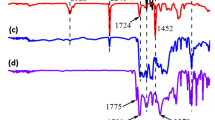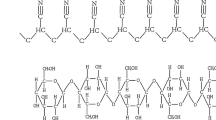Abstract
In this study, PAN-based carbon nanofibers (CNFs) were synthesized via electrospinning followed by stabilizing and carbonization. The carbonization process was performed by heating the fibrous mats up to a maximum temperature in the region of 800–1600 °C. The effect of carbonization maximal temperature on the structure and tensile strength of carbon nanofiber mats was investigated via SEM, elemental analysis, X-ray diffraction, Raman spectroscopy and tensile testing. Polyacrylonitrile (PAN) concentrations of 6–10% (w/w) and voltages of 14–16 kV were recognized as the optimal electrospinning parameters in order to synthesize of nanofibrous mats without any agglomerated nanoparticles or beads in the mats structure. It is clear from the results that carbon content, crystalline stacking size (Lc), in-plane crystallite size (La) and the number of graphene layers in single crystallite continuously increased with rising carbonization maximum temperature from 800 to 1600 °C, while interlayer d-spacing (d002) decreased at the maximum temperatures of 1000–1400 °C, firstly. This value increased again at the maximum temperatures above1400 °C due to the formation of considerable shrinkages and pores in the CNFs structure. The highest value of tensile strength (206–223 MPa) was recorded for the CNFs mats carbonized up to 1200–1400 °C.

















Similar content being viewed by others
References
Figueiredo JL, Bernardo CA, Baker RTK, Huttinger KJ (1990) Carbon fibers filaments and composites, 2nd edn. Kluwer academic publishers, Portugal
Li D (2004) Electrospinning of nanofibers: reinventing the wheel. Adv Mater 16:1151–1170. https://doi.org/10.1002/adma.200400719
Marcuzzo JS, Otani C, Aguiar Polidoro H, Otani S (2013) Influence of thermal treatment on porosity formation on carbon fiber from textile PAN. Mater Res 16:137–144. https://doi.org/10.1590/S1516-14392012005000165
Inagaki M, Yang Y, Kang F (2012) Carbon nanofibers prepared via electrospinning. Adv Mater 24:2547–2566. https://doi.org/10.1002/adma.201104940
Newcomb BA (2016) Processing, structure, and properties of carbon fibers. Compos Part A Appl Sci Manuf 91:262–282. https://doi.org/10.1016/j.compositesa.2016.10.018
Cai J, Li W, Zhao P, Yu J, Yang Z (2018) Low-cost and high-performance electrospun carbon nanofiber film anodes. Int J Electrochem Sci 13:2934–2944
Sutasinpromprae J, Jitjaicham S, Nithitanakul M, Meechaisue C, Supaphol P (2006) Preparation and characterization of ultrafine electrospun polyacrylonitrile fibers and their subsequent pyrolysis to carbon fibers. Polym Int 55:825–833. https://doi.org/10.1002/pi.2040
Park SH, Kim C, Yang KS (2004) Preparation of carbonized fiber web from electrospinning of isotropic pitch. Synth Met 143:175–179. https://doi.org/10.1016/j.synthmet.2003.11.006
Gu SY, Wu Q, Ren J (2008) Preparation and surface structures of carbon nanofibers produced from electrospun PAN precursors. New Carbon Mater 23:171–176. https://doi.org/10.1016/S1872-5805(08)60021-9
Sadighzadeh A, Valinejad M, Gazmeh A, Rezaiefard B (2016) Synthesis of Polymeric electrospun nanofibers for application in waterproof-breathable fbrics. Polym Eng Sci 1:143–149. https://doi.org/10.1002/pen.24200
Rajalingam P, Radhakrishnan G (1991) Polyacrylonitrile precursor for carbon fibers. JMS-REV Macromol Chem Phys C 31:301–310. https://doi.org/10.1080/15321799108021925
Rahaman MSA, Ismail AF, Mustafa A (2007) A review of heat treatment on polyacrylonitrile fiber. Polym Degrad Stab 92:1421–1432. https://doi.org/10.1016/j.polymdegradstab.2007.03.023
Ko TH, Day TC, Lin MF (1993) The effect of precarbonization on mechanical properties of final polyacrylonitrile-based carbon fibres. J Mater Sci Lett 12:343–345. https://doi.org/10.1007/BF01910099
Cohn SM, Das S(1998) A cost assessment of conventional PAN carbon fiber production technology, Energy division, Oak Ridge National laboratory, Tennessee, Unpublished draft
Deurbergue A, Oberlin A (1991) Stabilization and carbonization of pan-based carbon fibers as related to mechanical properties. Carbon 29:621–628. https://doi.org/10.1016/0008-6223(91)90129-7
Kostikov VI (1995) Fibre science and technology, 1st edn. Chapman and hall english, Netherland
Kim C, Park SH, Cho JI, Lee DY, Park TJ, Lee WJ, Yang KS (2004) Raman spectroscopic evaluation of polyacrylonitrile-based carbon nanofibers prepared by electrospinning. Raman Spectrosc 35:928–933. https://doi.org/10.1002/jrs.1233
Fitzer E, Frohs W, Heine M (1986) Optimization of stabilization and carbonization treatment of pan fibers and structural characterization of the resulting carbon fibers. Carbon 24:387–395. https://doi.org/10.1016/0008-6223(86)90257-5
Laffont L, Monthioux M, Serin V, Mathur RB, Guimon C, Guimon MF (2004) An EELS study of the structural and chemical transformation of PAN polymer to solid carbon. Carbon 42:2485–2494. https://doi.org/10.1016/j.carbon.2004.04.043
Al-Raeei M, El-Daher MS (2020) Temperature dependence of the specific volume of Lennard-Jones potential and applying in case of polymers and other materials. Polym Bull. https://doi.org/10.1007/s00289-020-03166-8
Brunauer S, Emmett PH, Teller E (1938) Adsorption of gases in multimolecular layers. J Am Chem Soc 60:309. https://doi.org/10.1021/ja01269a023
Zeng K, Minh DP, Gauthier D, Hortala EW, Nzihou A, Flamant G (2015) The effect of temperature and heating rate on char properties obtained from solar pyrolysis of beech wood. Biores Technol 182:114–119. https://doi.org/10.1016/j.biortech.2015.01.112
Bakar SSS, Foong KM, Halif NA, Yahud S (2019) Effect of solution concentration and applied voltage on electrospun polyacrylonitrile fibers. Mater Sci Eng 701:1–7. https://doi.org/10.1088/1757-899X/701/1/012018
Zhou G, Yu S, He L, Guo Q, Ye H (2012) The interpretation of X-ray diffraction from the pyrocarbon in carbon/carbon composites with comparison of TEM observations. Phil Mag 92:1198–1211. https://doi.org/10.1080/14786435.2011.640293
Warren BE (1941) X-Ray diffraction in random layer lattices. Phys Rev 59:693–698. https://doi.org/10.1103/PhysRev.59.693
Biscoe J, Warren BE (1942) An x-ray study of carbon black. J Appl Phys 13:364–371. https://doi.org/10.1063/1.1714879
Jorio A, Filho AGS (2016) Raman studies of carbon nanostructures. Annu Rev Mater Res 46:357–382. https://doi.org/10.1146/annurev-matsci-070115-032140
Knight DS, White WB (1989) Characterization of diamond films by Raman spectroscopy. J Mater Res 4:385–393. https://doi.org/10.1557/JMR.1989.0385
Bokobza L, Bruneel JL, Couzi M (2015) Raman spectra of carbon-based materials (from graphite to carbon black) and of some silicone composites. C-J Carbon Res 1:77–94. https://doi.org/10.3390/c1010077
Ferrari AC, Robertson J (2000) Interpretation of Raman spectra of disordered and amorphous carbon. Phys Rev B 61:14095–14107. https://doi.org/10.1103/PhysRevB.61.14095
Qanati MV, Rasooli A (2020) Functionalization of CNFs via wet chemical oxidation method in order to improve CNFs adhesion to matrix of carbon composites. Diam Relat Mater 109:1–9. https://doi.org/10.1016/j.diamond.2020.108097
Francis A, Sundberg A, Richard J (2007) Advanced organic chemistry carey, 5th ed, Springer US
Belenkov EA (2001) Formation of graphite structure in carbon crystallites. Inorg Mater 37:928–934. https://doi.org/10.1023/A:1011601915600
Fujimoto H, Mabuchi A, Tokumitsu K, Kasuh T (1994) Effect of crystallite size on the chemical compositions of the stage 1 alkali metal-graphite intercalation compounds. Carbon 32:193–198. https://doi.org/10.1016/0008-6223(94)90182-1
Jorgensen WL (2004) BOSS: Biochemical and organic simulation system user’s manual for UNIX, Linux, and windows, version 4.6, department of chemistry, Yale university
Belenkov EA, Brzhezinskaya MM, Greshnyakov VA (2017) Crystalline structure and properties of diamond-like materials. Nanosyst Phy Chem Math. https://doi.org/10.17586/2220-8054-2017-8-1-127-136
Sazali N (2019) The influence of carbonization temperature and heating rate towards carbon membrane performance: a review. J Adv Res Fluid Mech Therm Sci 62:151–158
Seitz JT (1993) The estimation of mechanical properties of polymers from molecular structure. J Appl Polym Sci 49:1331–1351. https://doi.org/10.1002/app.1993.070490802
Ávila AF, Lacerda GSR (2008) Molecular mechanics applied to single-walled carbon nanotubes. Mater Res 11:325–333. https://doi.org/10.1590/s1516-14392008000300016
Acknowledgements
The authors wish to thank Tabriz University for its support with this study. The results presented in this article is a part of the Ph. D. thesis by Mahdi Valinejad Qanati.
Author information
Authors and Affiliations
Corresponding author
Ethics declarations
Conflict of interests
The authors declare that they have no conflict of interest.
Additional information
Publisher's Note
Springer Nature remains neutral with regard to jurisdictional claims in published maps and institutional affiliations.
Rights and permissions
About this article
Cite this article
Qanati, M.V., Rasooli, A. & Rezvani, M. Main structural and mechanical properties of electrospun PAN-based carbon nanofibers as a function of carbonization maximum temperature. Polym. Bull. 79, 331–355 (2022). https://doi.org/10.1007/s00289-020-03520-w
Received:
Revised:
Accepted:
Published:
Issue Date:
DOI: https://doi.org/10.1007/s00289-020-03520-w




